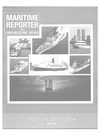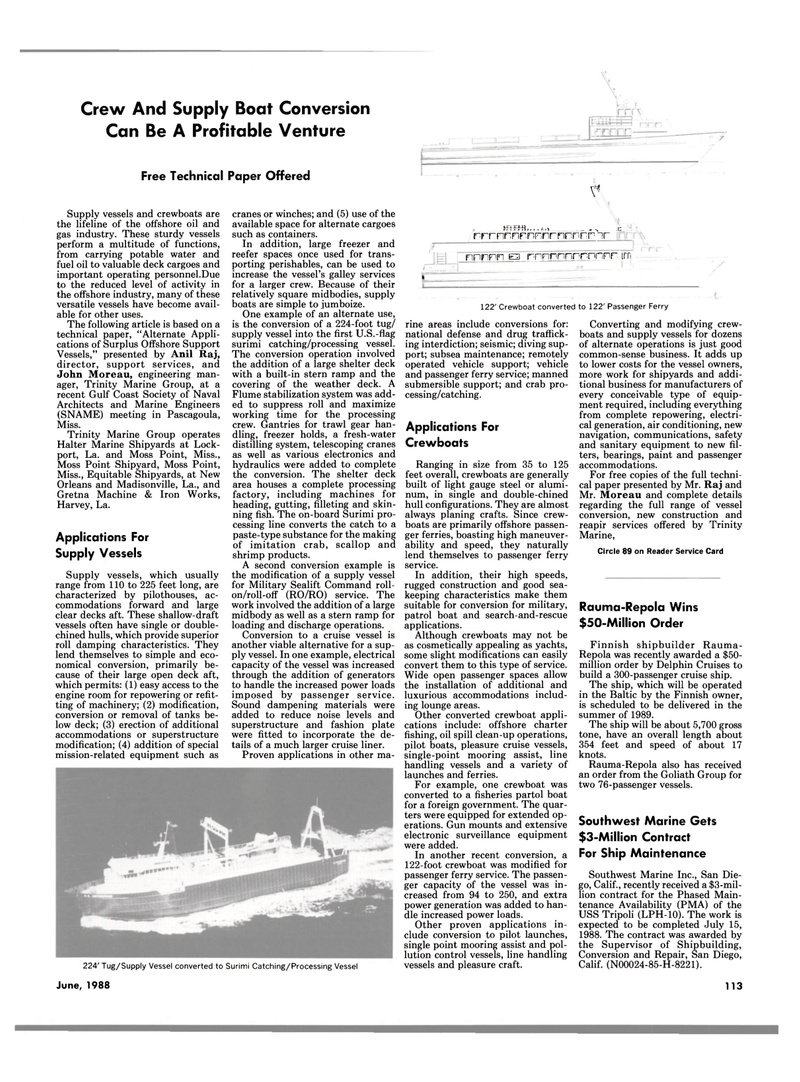
Page 105: of Maritime Reporter Magazine (June 1988)
Read this page in Pdf, Flash or Html5 edition of June 1988 Maritime Reporter Magazine
Crew And Supply Boat Conversion
Can Be A Profitable Venture
Free Technical Paper Offered
Supply vessels and crewboats are the lifeline of the offshore oil and gas industry. These sturdy vessels perform a multitude of functions, from carrying potable water and fuel oil to valuable deck cargoes and important operating personnel.Due to the reduced level of activity in the offshore industry, many of these versatile vessels have become avail- able for other uses.
The following article is based on a technical paper, "Alternate Appli- cations of Surplus Offshore Support
Vessels," presented by Anil Raj, director, support services, and
John Moreau, engineering man- ager, Trinity Marine Group, at a recent Gulf Coast Society of Naval
Architects and Marine Engineers (SNAME) meeting in Pascagoula,
Miss.
Trinity Marine Group operates
Halter Marine Shipyards at Lock- port, La. and Moss Point, Miss.,
Moss Point Shipyard, Moss Point,
Miss., Equitable Shipyards, at New
Orleans and Madisonville, La., and
Gretna Machine & Iron Works,
Harvey, La.
Applications For
Supply Vessels
Supply vessels, which usually range from 110 to 225 feet long, are characterized by pilothouses, ac- commodations forward and large clear decks aft. These shallow-draft vessels often have single or double- chined hulls, which provide superior roll damping characteristics. They lend themselves to simple and eco- nomical conversion, primarily be- cause of their large open deck aft, which permits: (1) easy access to the engine room for repowering or refit- ting of machinery; (2) modification, conversion or removal of tanks be- low deck; (3) erection of additional accommodations or superstructure modification; (4) addition of special mission-related equipment such as cranes or winches; and (5) use of the available space for alternate cargoes such as containers.
In addition, large freezer and reefer spaces once used for trans- porting perishables, can be used to increase the vessel's galley services for a larger crew. Because of their relatively square midbodies, supply boats are simple to jumboize.
One example of an alternate use, is the conversion of a 224-foot tug/ supply vessel into the first U.S.-flag surimi catching/processing vessel.
The conversion operation involved the addition of a large shelter deck with a built-in stern ramp and the covering of the weather deck. A
Flume stabilization system was add- ed to suppress roll and maximize working time for the processing crew. Gantries for trawl gear han- dling, freezer holds, a fresh-water distilling system, telescoping cranes as well as various electronics and hydraulics were added to complete the conversion. The shelter deck area houses a complete processing factory, including machines for heading, gutting, filleting and skin- ning fish. The on-board Surimi pro- cessing line converts the catch to a paste-type substance for the making of imitation crab, scallop and shrimp products.
A second conversion example is the modification of a supply vessel for Military Sealift Command roll- on/roll-off (RO/RO) service. The work involved the addition of a large midbody as well as a stern ramp for loading and discharge operations.
Conversion to a cruise vessel is another viable alternative for a sup- ply vessel. In one example, electrical capacity of the vessel was increased through the addition of generators to handle the increased power loads imposed by passenger service.
Sound dampening materials were added to reduce noise levels and superstructure and fashion plate were fitted to incorporate the de- tails of a much larger cruise liner.
Proven applications in other ma-
V ^{^rTTHn-• • i^ii r rrrrrrrrFrrrrrrr'T nrnpn h nnnrinonnnnpn r.n
E 122' Crewboat converted to 122' Passenger Ferry 224' Tug/Supply Vessel converted to Surimi Catching/Processing Vessel rine areas include conversions for: national defense and drug traffick- ing interdiction; seismic; diving sup- port; subsea maintenance; remotely operated vehicle support; vehicle and passenger ferry service; manned submersible support; and crab pro- cessing/catching.
Applications For
Crewboats
Ranging in size from 35 to 125 feet overall, crewboats are generally built of light gauge steel or alumi- num, in single and double-chined hull configurations. They are almost always planing crafts. Since crew- boats are primarily offshore passen- ger ferries, boasting high maneuver- ability and speed, they naturally lend themselves to passenger ferry service.
In addition, their high speeds, rugged construction and good sea- keeping characteristics make them suitable for conversion for military, patrol boat and search-and-rescue applications.
Although crewboats may not be as cosmetically appealing as yachts, some slight modifications can easily convert them to this type of service.
Wide open passenger spaces allow the installation of additional and luxurious accommodations includ- ing lounge areas.
Other converted crewboat appli- cations include: offshore charter fishing, oil spill clean-up operations, pilot boats, pleasure cruise vessels, single-point mooring assist, line handling vessels and a variety of launches and ferries.
For example, one crewboat was converted to a fisheries partol boat for a foreign government. The quar- ters were equipped for extended op- erations. Gun mounts and extensive electronic surveillance equipment were added.
In another recent conversion, a 122-foot crewboat was modified for passenger ferry service. The passen- ger capacity of the vessel was in- creased from 94 to 250, and extra power generation was added to han- dle increased power loads.
Other proven applications in- clude conversion to pilot launches, single point mooring assist and pol- lution control vessels, line handling vessels and pleasure craft.
Converting and modifying crew- boats and supply vessels for dozens of alternate operations is just good common-sense business. It adds up to lower costs for the vessel owners, more work for shipyards and addi- tional business for manufacturers of every conceivable type of equip- ment required, including everything from complete repowering, electri- cal generation, air conditioning, new navigation, communications, safety and sanitary equipment to new fil- ters, bearings, paint and passenger accommodations.
For free copies of the full techni- cal paper presented by Mr. Raj and
Mr. Moreau and complete details regarding the full range of vessel conversion, new construction and reapir services offered by Trinity
Marine,
Circle 89 on Reader Service Card
Rauma-Repola Wins $50-Million Order
Finnish shipbuilder Rauma-
Repola was recently awarded a $50- million order by Delphin Cruises to build a 300-passenger cruise ship.
The ship, which will be operated in the Baltic by the Finnish owner, is scheduled to be delivered in the summer of 1989.
The ship will be about 5,700 gross tone, have an overall length about 354 feet and speed of about 17 knots.
Rauma-Repola also has received an order from the Goliath Group for two 76-passenger vessels.
Southwest Marine Gets $3-Million Contract
For Ship Maintenance
Southwest Marine Inc., San Die- go, Calif., recently received a $3-mil- lion contract for the Phased Main- tenance Availability (PMA) of the
USS Tripoli (LPH-10). The work is expected to be completed July 15, 1988. The contract was awarded by the Supervisor of Shipbuilding,
Conversion and Repair, San Diego,
Calif. (N00024-85-H-8221).
June, 1988 113

 104
104

 106
106
